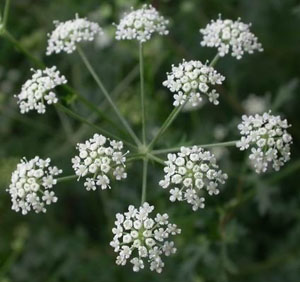 Fang Feng, a widely known herb in Traditional Oriental Medicine, seems to be a cornucopia of biologically active natural substances that can benefit human health. Such biochemical diversity reflects the versatility of its traditional therapeutic effects. The herb was used to relieve arthritis, the common cold, chills, fevers, and body pains. It was also prescribed for treating wind-heat conditions of the body such as sore throats and headaches.
Fang Feng, a widely known herb in Traditional Oriental Medicine, seems to be a cornucopia of biologically active natural substances that can benefit human health. Such biochemical diversity reflects the versatility of its traditional therapeutic effects. The herb was used to relieve arthritis, the common cold, chills, fevers, and body pains. It was also prescribed for treating wind-heat conditions of the body such as sore throats and headaches.
Chemical Diversity
Fang Feng is known to modern science by the scientific names Ledebouriella divaricata or Saposhnikovia divaricata. In western herbal medicine the root herb is referred to as Radix Saposhnikoviae. It is classified as a species in the carrot family, Apiaceae, which is known for a fascinating array of natural products with diverse biological activities. Natural products chemists have discovered dozens of different substances in Fang Feng. The main constituents span several classes of chemical types, including chromones, coumarins, polyacetylenes, essential oils, and polysaccharides. Of these, the chromones and coumarins have attracted the most interest in herbal medical research. The chromones and the coumarins of the carrot family impart particular effects on skin in response to UV light. Indeed, one of the better known coumarins, called psoralen, is used in modern medicine for treating skin problems such as psoriasis. The basis for this treatment is the interaction between psoralen and UV light in skin cells. These effects may also explain some of the benefits of Fang Feng for natural skin care.
Fang Feng Research
Modern scientific research on this herb is still in its infancy. The earliest publications on its chemical constituents appeared in the 1980s. These have been followed more recently by studies of the pharmacological actions of many of these constituents. The main actions that have been demonstrated so far are:
- Antipyretic (reduction of fever)
- Anti-shock
- Antibiotic
- Analgesic (pain relief)
- Anti-proliferative (suppression of tumor cell growth)
- Anti-inflammatory
The most recent research study focused on the anti-inflammatory action of one particular coumarin in the roots of Saposhnikovia, called anomalin. This study was conducted at the Natural Products Research Institute, College of Pharmacy, Seoul National University, South Korea, and published in the Journal of Cellular Biochemistry in 2011. This study found that anomalin powerfully reduced the production of several pro-inflammatory hormones in response to an induced cellular inflammation. The authors concluded that anomalin is a major anti-inflammatory agent that is a potential therapeutic candidate for the treatment of inflammatory disorders. As such, it may be a natural replacement for synthetic anti-inflammatory drugs that have been on the market for decades.
Herbal Formulas with Fang Feng
Traditional Oriental Medicine famously combines herbs such as Fang Feng into numerous formulas for a wide variety of health applications. Modern formulations that enhance the benefits of Fang Feng now entail combining such well-known herbs as burdock, mulberry, peony, and stephania. Herbal formulas containing these and other key ingredients are the basis for the soothing and detoxifying effects of herbal soaks and lotions. See for yourself how good you feel after a warm, relaxing bath with just the right herbs, including Fang Feng, in the Total Body Detox Soak by Jadience Herbal Formulas.




